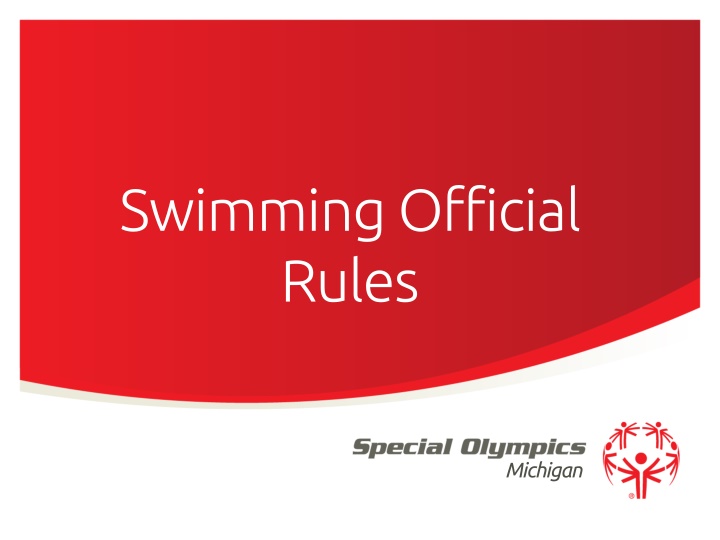
Michigan Swimming Official Rules and Event Guidelines
Explore the official swimming rules and guidelines for Michigan, including information on the sport season, offered events, uniform requirements, general rules, and more. Learn about the specific events available, participant restrictions, proper attire, and key regulations to follow for a successful swimming experience in Michigan.
Download Presentation

Please find below an Image/Link to download the presentation.
The content on the website is provided AS IS for your information and personal use only. It may not be sold, licensed, or shared on other websites without obtaining consent from the author. If you encounter any issues during the download, it is possible that the publisher has removed the file from their server.
You are allowed to download the files provided on this website for personal or commercial use, subject to the condition that they are used lawfully. All files are the property of their respective owners.
The content on the website is provided AS IS for your information and personal use only. It may not be sold, licensed, or shared on other websites without obtaining consent from the author.
E N D
Presentation Transcript
Swimming Official Rules Michigan
The Basics Sport season: February - June Culminating State Events: State Summer Games
Events Offered Events Offered: Freestyle: 25-Yard 50-Yard 100-Yard 200-Yard* 400-Yard* Freestyle Relay: 4X25 Yard* 4X50 Yard* Unified: 4 x 25 Yard Freestyle Relay 4 x 50 Yard Freestyle Relay 4 x 100 Yard Freestyle Relay 4 x 200 Yard Freestyle Relay 4 x 25 Yard Medley Relay 4 x 50 Yard Medley Relay 4 x 100 Yard Medley Relay Developmental Swim Events: Assisted Swim: 10-Yard 15-Yard 25-Yard Flotation: 15-Yard 25-Yard 25-Yard Back Breaststroke: 25-Yard 50-Yard Backstroke: 25-Yard 50-Yard 100-Yard Butterfly: 25-Yard 50-yard Individual medley: 100-Yard*
Uniform Female athletes will wear a one-piece tank suit with no cutouts. Male athletes will wear a brief type racing suit or boxer suit with intermesh lining or any manufactured swimsuit. Athletes are required to wear swimsuits that are within the guidelines of the Federation Internationale de Natacion Amateur (FINA and MHAS). An exception may be granted by the Technical Delegate/Meet Referee/Meet Director for medical, cultural, religious or modesty reasons. These exceptions should allow male and female swimmers to cover a greater part/parts of the body but all swimwear must be made of textile material.
Uniform Suits should not be transparent even when wet. The SOMI logo is not required on the swimsuit. Athletes are prohibited from competing in T-shirts. Referees have the authority to exclude any competitor who does not comply with the guidelines. An exception may be granted by the Technical Delegate/Meet Referee/Meet Director for medical, cultural, religious or modesty reasons. These exceptions should allow male and female swimmers to cover a greater part/parts of the body, but all swimwear must be made of textile material. Swim caps and goggles are highly recommended. Jewelry may not be worn.
General Rules No more than 50% of your delegation may enter swimming events. You can register athletes for 1 to 3 events (including relays). All swimming events should be timed and measured in yards. Do not convert time to meters. Each swimmer will be allowed one false start. Upon committing a second false start, that swimmer will be disqualified. In all cases where a false start occurs, the race will be recalled. Any swimmer with two false starts will not be permitted to swim.
General Rules Dive starts are not allowed at Summer Games. In water starts will be utilized. Athlete shall place one hand on the end of the pool or hold the starting block with one hand. Two hands shall be used for backstroke starts Standing on the bottom during freestyle events or during the freestyle portion of the medley events shall not disqualify a competitor, but he/she shall not walk. Standing upon the bottom in the racing course is allowed only for the purpose of resting. Walking on or jumping from the bottom will disqualify the offender.
General Rules A coach or official may guide the swimmer by voice only. The aide is not allowed to touch the swimmer during the race. The exception to this rule is assisted swim races. Assistant starters or volunteers may be used to help athletes maintain their positions at the starting line. No competitor shall be permitted to use or wear any device that may aid their speed, buoyancy or endurance during a competition such as webbed gloves, flippers or fins. The exception to this is the flotation races.
General Rules Swimmers may be assisted from the water upon request. Area representatives are only allowed on deck for the duration of their athlete s swim. No more than two area representatives may accompany an athlete on deck. All times submitted in aquatics events should be measured in yards. If your pool measures in meters, please contact the state office before submitting times.
General Rules If in the judgment of the referee or competition management an athlete is not capable of completing the race distance and may even put his/her life in danger, the referee may, with the Technical Delegate s approval, require a test of swimming competence before the athlete is allowed to compete in any further swimming event or in any final. Competition management reserves the right to move the athlete to a more appropriate distance or stroke if necessary.
Starting a Race This is the current procedure for starting a race: Clear the pool of the previous race s swimmers and bring the new swimmers into the water. Notify the times to clear their watches. Using the bullhorn state, swimmers take your mark Blow the whistle, as well as move your arm vertically from above your head to your waist (for any swimmers who may have hearing impairments) to indicate the start of the race.
Stroke Specifications The arms in butterfly must move together both in and out of the water. For butterfly and breaststroke both hands must touch the wall simultaneously at the turns and finish of the race
Stroke Specifications Freestyle The swimmer may swim any style, except in individual medley or medley relay events. Freestyle means any style other than backstroke, breaststroke, or butterfly. Some part of the swimmer must touch the wall upon completion of each length and at the finish. Some part of the swimmer must break the surface of the water throughout the race, except at the turn the swimmer can be submerged. The swimmers head must surface within 16.5 yards after the start of each turn.
Grounds for Disqualifications Grounds for disqualification include: Changing to a different stroke during a race. Using any stroke that is not the pro-posed stroke for the race. Using leg movements or arm movements that don't coincide with the stroke. For example, the athlete uses front crawl arms and breaststroke kick.
Relays There shall be four swimmers on each relay team. Each swimmer shall swim one-fourth the distance of the total relay. No swimmer shall swim more than one leg of any one relay. Relay team members must come from within the same delegation. A relay team, which combines genders to include both male and female athletes, shall compete as a male relay.
Relays Relay swimmers should exit the pool as soon as possible following the completion of their relay leg. Relay swimmers who cannot exit the water immediately may be allowed to remain in the lane until all relays have finished so long as they do not interfere with the other swimmers or the timing equipment. A swimmer remaining in the water should move a short distance away from the end of the pool, close to the lane rope but shall not obstruct a swimmer in another lane. Obstruction of a swimmer in another lane shall cause the team to be disqualified.
Relays Please designate appropriate alternates for use on relay teams. If a four-member team loses a member due to illness/injury, etc. only the designated alternate(s) on the relay team registration form may substitute. If an athlete is dropped and no registered alternate is available the entire relay team is dropped.
Unified Relays Unified Relays Each Unified Sports relay team shall consist of two athletes and two partners. Swimmers on a Unified Sports relay team may be assigned to swim in any order.
Developmental Swimming Flotation Races Flotation events are for athletes requiring flotation devices but swim independently. Athletes who swim independently in the 15- and 25-yard free floatation may not also swim in the 25-yard assisted swim as they do not require assistance. If they don t swim on their back independently an appropriate third event for them would be an assisted race on their back. Each athlete is responsible for his/her own floatation device.
Developmental Swimming The device must be the body wraparound type such that is the athlete were not to be able to hold onto the device, the device would still support the athlete with his/her face out of the water. (Floatation devices such as kickboards, inner tubes, floats that wrap around the arms or NOODLES are not acceptable).
Developmental Swimming General Rules Assisted Swims Each athlete is responsible for having his/her own coach/assistant with them in the water. The assistant may touch, guide or direct the athlete, but may not support or assist with the athlete s forward movement. Swimmers are allotted to use a flotation device if necessary. The device must be the body wraparound type such that is the athlete were not to be able to hold onto the device, the device would still support the athlete with his/her face out of the water. (Floatation devices such as kickboards, inner tubes, floats that wrap around the arms or NOODLES are not acceptable).
Safety Considerations All Special Olympics swimming training, recreational sessions and competition events shall be conducted in accordance with the following practices, rules and procedures in order to ensure the safety and well- being of all Special Olympics athletes, coaches and volunteers: There shall be at least one certified lifeguard on duty for every 25 swimmers in the water. The sole function of the lifeguard shall be to guard. If no relief lifeguard is available, the pool must be cleared, even for a short duration, when a lifeguard must leave the pool side.
Safety Considerations The Event Director will review the Emergency Action Plan prior to each occasion. Athlete medical history forms shall be on site and relevant information shall be discussed with the lifeguard or medical personnel on duty in advance of the aquatic activity. There shall be enough coaches in accordance with FINA or program NGB guidelines. Pool depths must be marked and easily visible. The minimum depth of the pool for racing starts shall meet FINA or NGB specifications.
Safety Considerations It is recommended that all starting blocks meet FINA or NGB specifications. Safety lines must be in place to divide shallow and deep water areas during recreational aquatic activities. A pool facility shall not be used unless a satisfactory inspection rating is received prior to any Special Olympics participant entering the water.
Safety Considerations An athlete with Down syndrome who has been diagnosed with Atlanto-Axial Instability may not participate in Butterfly events, Individual Medley events, diving starts or diving. For additional information and the procedure for waiver of this restriction, please refer to Article I, Addendum F.
Emergency Action Plan An Emergency Action Plan shall be in place prior to any Special Olympics participants entering the water for any reason, be it training, competition or recreation. The original plan should be written and reviewed by the staff on hand. The plan shall include the following: The procedure for obtaining emergency medical support if a medical doctor, paraprofessional or medical support is not present. The posts and areas of responsibilities for each lifeguard.
Emergency Action Plan The procedure for obtaining weather information or weather watch information, particularly if the event is outside. The procedure for reporting accidents. The chain of command in case of a serious accident, including who is assigned to talk to the press. The procedure for obtaining weather information particularly for Open Water swimming.


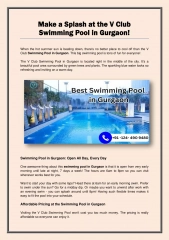
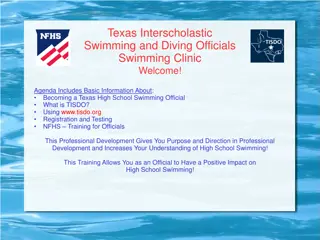
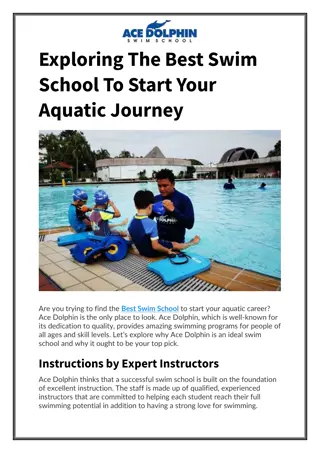
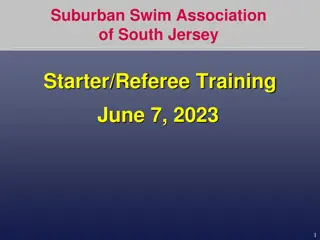

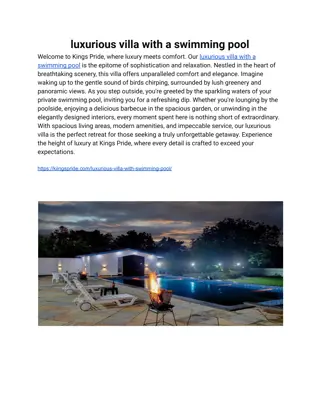





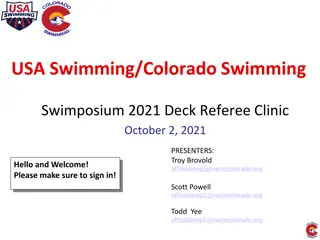


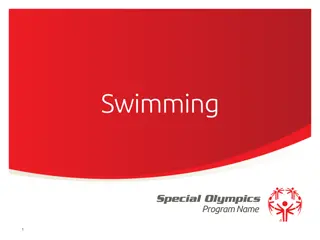
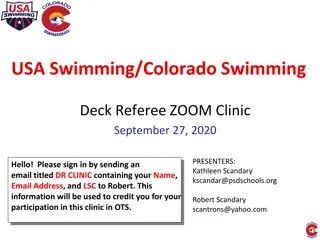
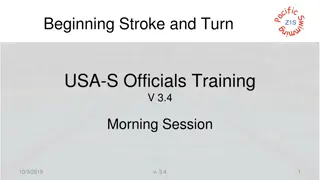



![USA Swimming and [Insert LSC Here] Starter Clinic Overview](/thumb/162824/usa-swimming-and-insert-lsc-here-starter-clinic-overview.jpg)